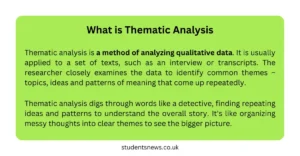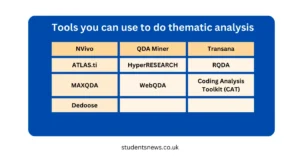What should you know about thematic analysis
Thematic analysis is a method of analyzing qualitative data by identifying, analyzing, and reporting patterns (themes) within the data.

Thematic analysis involves several key steps:
- Familiarization with the Data: This initial step involves immersing oneself in the data, often by reading and re-reading transcripts, notes, or any other forms of collected data. The goal is to become thoroughly familiar with the content.
- Generating Initial Codes: In this step, the researcher identifies and labels relevant features of the data that appear interesting or significant. Coding can be done manually or using software. Codes are basic segments or elements of the raw data that can be assessed in a meaningful way regarding the phenomenon. This is a little complex step that sometimes become one of the limitations of thematic analysis for students.
- Searching for Themes: This step involves examining the codes and collated data to identify broader patterns of meaning. Themes are overarching categories that capture significant patterns in the data. It often involves grouping similar codes together to form initial themes.
- Reviewing Themes: In this phase, the researcher refines the themes by checking if they work in relation to the coded extracts and the entire data set. This may involve splitting, combining, or discarding themes to ensure they accurately reflect the data.
- Defining and Naming Themes: Each theme is further refined and defined, clarifying what each theme captures and ensuring that there is a clear distinction between themes. The researcher also develops detailed analyses of each theme and considers how they fit together to tell a coherent story about the data.
- Writing the Report: The final step involves compiling the analysis into a structured report. This includes a narrative that describes each theme, supported by data extracts, and demonstrates how the themes relate to the research question and existing literature. Being able to write a good report is one of the advantages of thematic analysis.
These steps provide a flexible yet systematic framework for conducting thematic analysis, allowing researchers to derive meaningful insights from qualitative data.
It has two major types:
- Deductive Thematic Analysis
- Inductive Thematic Analysis

There are many tools that can be used to do thematic analysis.

In this article, we will discuss the advantages and disadvantages of thematic analysis. There are many pros and cons of thematic analysis which will also be discussed here.
Advantages of Thematic Analysis
Thematic analysis has several advantages:
- Flexibility: It can be used with different types of data, like interviews, surveys, or texts, and across various research questions and disciplines.
- Accessibility: It’s straightforward and easy to learn, making it accessible for researchers with different levels of experience.
- Depth of Understanding: It allows for detailed and nuanced exploration of data, helping to uncover deep insights into people’s experiences and perceptions.
- Rich Description: It provides a rich and detailed account of data, capturing complex phenomena in a structured way.
- Pattern Recognition: It helps identify and highlight common themes or patterns in data, making it easier to see connections and trends.
- Transparency: The systematic approach makes the analysis process clear and transparent, which enhances the credibility of the research findings.
Thus,, thematic analysis has many pros. This does not mean that there are no pros and cons of thematic analysis. In the next section, we will discuss the cons or limitation of thematic analysis.
Disadvantages of Thematic Analysis
Thematic analysis also has some disadvantages:
- Subjectivity: The process of identifying themes can be subjective, as it relies on the researcher’s interpretation of the data, which can lead to bias.
- Time-Consuming: Analyzing large amounts of qualitative data can be very time-consuming and requires careful attention to detail.
- Lack of Depth: While it provides an overview of patterns in the data, it may not always capture the deeper, underlying issues or the full complexity of the data.
- Potential for Over-Simplification: There’s a risk of over-simplifying the data by focusing on themes and not considering the context in which data is situated.
- Difficulty in Identifying Themes: Determining what constitutes a theme can be challenging and requires a certain level of experience and skill.
- Limited to Manifest Content: It often focuses on what is explicitly stated, potentially overlooking implicit meanings or non-verbal data.
These are the disadvantages of thematic analysis. These cons serve as the limitations of thematic analysis.
Comparison and Advantages and Disadvantages of Thematic Analysis
Here is a comparison of the advantages and disadvantages of thematic analysis in table form:
| Aspect | Advantages | Disadvantages |
|---|---|---|
| Flexibility | Can be used with various types of data and research questions | May lack specific guidelines, leading to inconsistency |
| Accessibility | Easy to learn and apply for researchers of all experience levels | Requires careful attention to detail, which can be demanding |
| Depth of Understanding | Provides detailed exploration of data | May not capture deeper underlying issues or full complexity |
| Rich Description | Offers a structured, detailed account of data | Risk of over-simplifying data and missing contextual nuances |
| Pattern Recognition | Identifies common themes and trends | Determining what constitutes a theme can be subjective and challenging |
| Transparency | Systematic approach enhances credibility | Can be time-consuming and labor-intensive |
| Subjectivity | Enables personal insight and intuition in analysis | Can lead to researcher bias and affect reliability |
| Manifest Content | Focuses on explicit data for clarity | Often overlooks implicit meanings or non-verbal data |
This table summarizes the key advantages and disadvantages, offering a clear comparison for understanding the strengths and limitations of thematic analysis.
So, do the Disadvantages overweigh the Advantages of Thematic Analysis
The disadvantages of thematic analysis do not necessarily outweigh the advantages. The decision depends on the specific needs and context of your research.
Advantages often outweigh disadvantages when:
- You need a flexible and accessible method.
- You are exploring complex and nuanced data.
- You value rich, detailed descriptions and patterns in data.
Disadvantages might be more significant when:
- You require a highly objective and quantitative approach.
- You are constrained by time and resources.
- The risk of bias is a critical concern.
In many cases, the advantages of thematic analysis provide substantial benefits that can justify its use, despite its limitations.
When should you best use Thematic Analysis
Thematic analysis is best used in the following situations, considering its advantages and disadvantages:
- Exploratory Research:
- When you are exploring new or complex phenomena where flexibility and depth are crucial.
- In early stages of research to identify patterns and generate hypotheses.
- Qualitative Data:
- When you have qualitative data from interviews, focus groups, open-ended survey responses, or textual data.
- To gain insights into participants’ experiences, perceptions, and motivations.
- Rich Description:
- When a detailed and nuanced understanding of the data is needed.
- When you want to provide a comprehensive account of patterns within the data.
- Pattern Identification:
- When identifying common themes or trends in the data is important for your research question.
- When understanding recurring issues or topics within a dataset is crucial.
- Practical Constraints:
- When time and resources allow for a thorough and detailed analysis.
- When you have the capacity to manage and systematically analyze large amounts of qualitative data.
When to Consider Other Methods:
- Objectivity Required:
- When the research demands a high level of objectivity and minimal researcher bias.
- When quantitative analysis is more appropriate for your research question.
- Time Constraints:
- When you have limited time or resources, and the extensive process of thematic analysis is not feasible.
- Implicit Meanings:
- When the study focuses heavily on implicit meanings, non-verbal data, or deeper underlying issues that thematic analysis might miss.
- Highly Structured Data:
- When the data is highly structured and better suited for other qualitative or mixed methods analysis techniques, like grounded theory or content analysis.
In summary, thematic analysis is best used when you need flexibility, rich detail, and pattern recognition in qualitative data, and when you have the time and resources to manage a thorough analysis. It is less suitable when objectivity, quantitative analysis, or implicit meanings are the primary focus.
Conclusion
Thematic analysis is like a detective’s toolkit for researchers. It’s great for digging deep into qualitative data, finding patterns, and uncovering hidden gems in people’s stories. It’s flexible, easy to pick up, and offers rich insights.
But, it’s not all sunshine and rainbows. It can be a bit of a time hog, and since it relies on the researcher’s intuition, bias can sneak in. Plus, it’s easy to oversimplify things if you’re not careful.
Use thematic analysis when you have the time and want to explore complex topics deeply. Maybe skip it if you need something quick, objective, or super structured.
In the end, it’s a trade-off. Weigh the pros and cons based on your research needs. When done right, thematic analysis can turn your data into a treasure trove of insights. Happy analyzing!



[…] Thematic analysis is a qualitative research method used to identify, analyze, and report patterns (themes) within data. It involves systematically examining the data to find repeated patterns of meaning. It has advantages as well as disadvantages. […]
[…] analysis has two main types which are inductive and deductive thematic analysis. There are many advantages and disadvantages of thematic analysis that should be […]